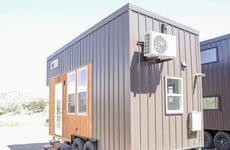
Baluchon Designs the Eucalyptus Tiny Home Structure
Amy Duong — February 24, 2024 — Art & Design
References: tinyhouse-baluchon.fr & yankodesign
Baluchon's latest creation comes in the form of the Eucalyptus tiny home. It is thoughtfully created and based on a double-axle trailer foundation, measuring 22 feet in length. This is about 3 feet longer than the company's typical designs.
The brand compacts all of the features into one level, making it very accessible for guests to enjoy in a snug interior. In terms of the design, it is clad in red cedar and is framed by spruce retail. The insulation is made using a blend of linen, recycled cotton, and hemp. When entering the home, guests go through a double glass door and right into the kitchen, which has an oven, small stove, fridge, cabinet, and sink.
Image Credit: Baluchon
The brand compacts all of the features into one level, making it very accessible for guests to enjoy in a snug interior. In terms of the design, it is clad in red cedar and is framed by spruce retail. The insulation is made using a blend of linen, recycled cotton, and hemp. When entering the home, guests go through a double glass door and right into the kitchen, which has an oven, small stove, fridge, cabinet, and sink.
Image Credit: Baluchon
Trend Themes
1. Double-axle Trailer Foundations - Innovative tiny home designs are increasingly utilizing double-axle trailer foundations for mobility and flexibility in housing solutions.
2. Sustainable Insulation Materials - The shift towards using eco-friendly materials like linen, recycled cotton, and hemp for insulation in tiny homes showcases a growing trend towards sustainability in construction.
3. Compact Single-level Living Spaces - Designing tiny homes with all features on one level creates highly accessible and functional living spaces that prioritize convenience and comfort.
Industry Implications
1. Tiny Home Construction - The tiny home construction industry can explore opportunities to innovate by incorporating double-axle trailer foundations for increased mobility and adaptability in housing solutions.
2. Eco-friendly Materials - Industries focused on sustainable construction materials can capitalize on the demand for eco-friendly insulation options like linen, recycled cotton, and hemp in tiny home designs.
3. Interior Design and Space Optimization - The interior design industry can tap into the trend of compact single-level living spaces in tiny homes by creating innovative layouts that maximize functionality in smaller environments.
4.8
Score
Popularity
Activity
Freshness























